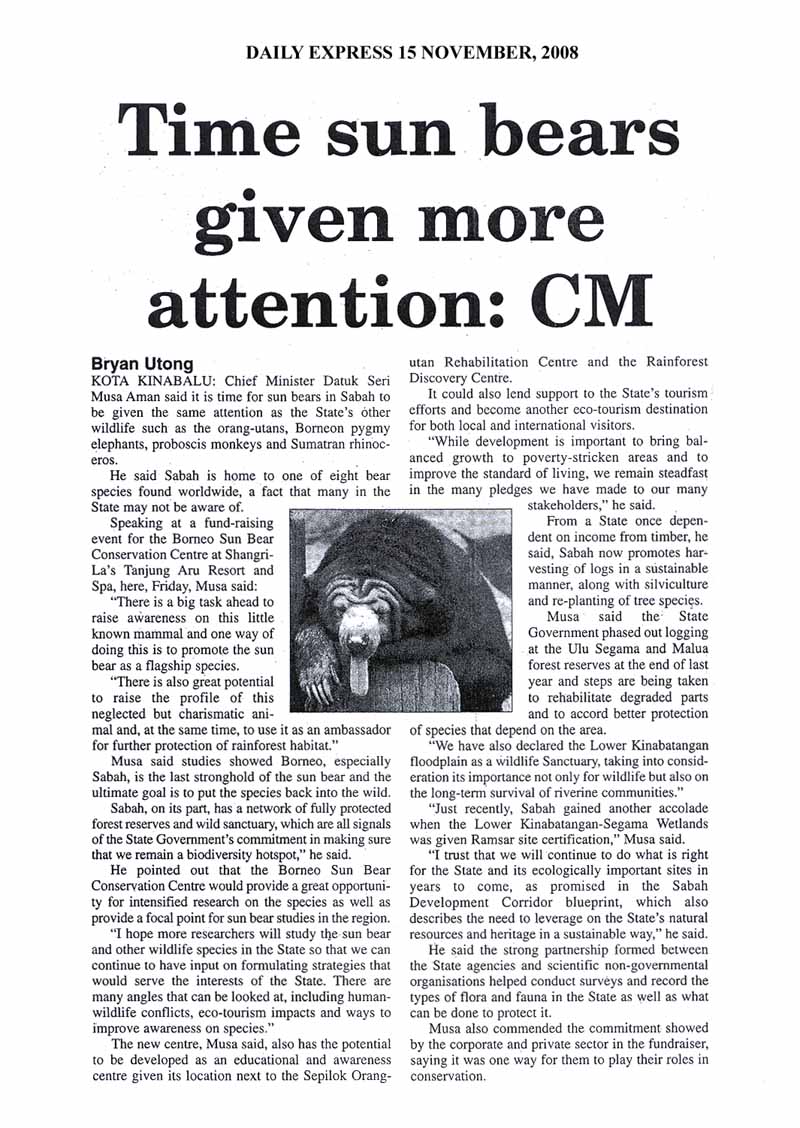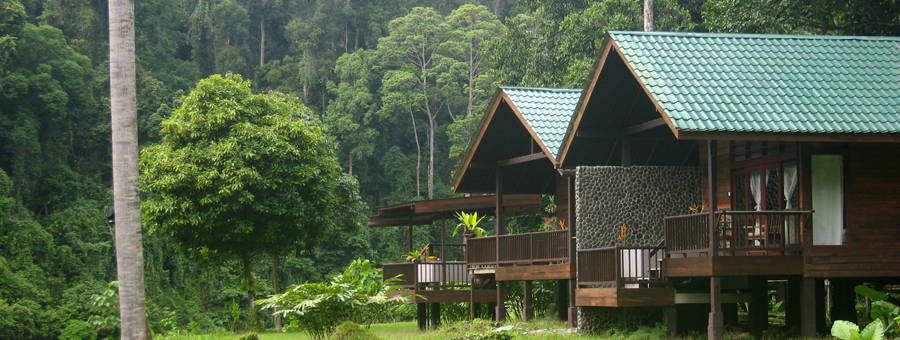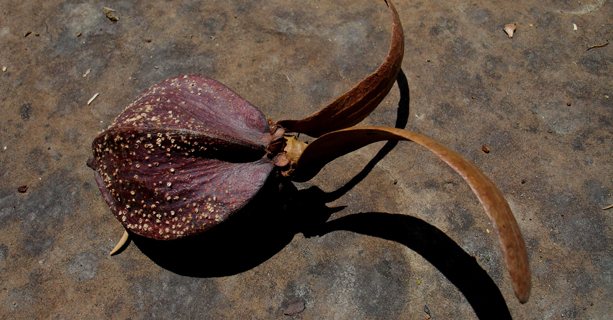Time Running Out For Sun Bears
Original article at NST Archives
New Straits Times – Nov 3, 2008
FOR all the conservation efforts on which Malaysia prides itself, there is surprisingly little that we know of the Malayan sun bear. EVANGELINE MAJAWAT and JULIA CHAN sniff around in search of these elusive creatures and stumble upon a concerted effort to protect this threatened species.
A NAUSEATING stench of faeces and rotting food fills the air. In the far corner of a lush garden stands a rusty metal cage – the source of the offending smell.
In the cage, barely a metre in height, a listless sun bear repeatedly rubs itself against the bars.
The cage is far too small for the sun bear, so much so that there is no space for it to move. Its once coal black fur is now a pale brown, with bald patches from rubbing against the cage too often. Its skin is covered with sores.
But more disturbing are the mounds of rotting fruits and vegetables, and the faeces in the cage. In a bowl, there is murky water.
These are the terrible conditions in which captive sun bears are kept in this country.
Malayan sun bears (Helarctos malayanus) are still kept illegally as pets in Malaysia and neighbouring Indonesia despite strict laws which prohibit the capture and trade of these animals.
But an innovative sun bear conservation centre, the first of its kind in Malaysia, brings renewed hope to the protection and conservation of the world’s smallest bear.
The Bornean Sun Bear Conservation Centre (BSBCC), being built in Sandakan, may just prove instrumental in protecting and rehabilitating captive bears.
These bears are often orphans, kept as pets or rescued from human-wildlife conflicts.
"These animals are often found in the most deplorable situations. Some are confined to spaces so small that there isn’t enough room to move. Others are kept in filthy cages filled with rotting food and faeces," said BSBCC chief executive officer Wong Siew Te.
The centre will be set up next to the world-renowned Sepilok Orang Utan Rehabilitation Centre.
Construction of the RM2.1 million project has begun and is expected to be completed by the middle of next year. The centre can house up to 43 sun bears but could take in more, depending on the bear‘s age and size.
The centre features a bear house, observation deck and a section of forest enclosure. The forest enclosure is crucial in rehabilitating traumatised bears in the hope of returning them to the wild some day.
"Bears which still display wild instincts will be released back into the forest," said the Penang-born Wong.
Sadly, bears which have been de-clawed or have lost their instincts and which do not fear humans will never roam the forests as they would not be able to fend for themselves.
"Some of these captive bears were de-clawed. It’s like chopping our fingers off. These bears will never be able to make it in the wild.
"Time is running out for these animals. To put things into perspective, there are about 41,000 orang utans in Borneo alone. But there are only 10,000 sun bears left worldwide. The situation isn’t good," he said.
Just last year, the World Conservation Union (IUCN) classified the sun bear as "vulnerable". Scientists fear that unless urgent conservation is put into place, the sun bears will suffer the same fate as the Javan tiger (Panthera tigris sondaica) which went extinct in the 1980s.
Previously listed as "Data Deficient", the sun bear is now included in the IUCN’s Red List of Threatened Species, drawn up last year.
The centre’s director, Cynthia Ong, said there were 11 bears being housed there.
"Habitat loss and poachers who go for the bear‘s gallbladder, whose bile is said to have medicinal values, are also contributing to the rapid depletion of the species."
Wong’s biggest challenge is securing funds to make this bear haven a reality. Competition is stiff for funding and research against more popular species, such as the Bornean orang utan.
"Sun bears are the least studied of the bears. It’s almost as if they’re a forgotten species. It isn’t easy convincing corporate bodies to fund a project which protects a little-known species," the 39-year-old sun bear expert said.
So far, Wong has secured RM300,000 from American-based non-profit organisation Alexander Abraham Foundation.
Size, it seems, does matter when it comes to getting funding for animal protection.
Large animals, apparently, ooze a "sex appeal" which attracts and seduces conservationists, corporate giants and governments to come running to the animals’ aid.
"The larger mammals – tigers, elephants, rhinoceros – have long been considered as the `sexy’ species. On average, in a year, you would naturally hear more stories about elephants and tigers in the media, as opposed to sun bears," said Malaysian Nature Society policy officer (conservation department) Kanitha Krishnasamy.
She said these "sexy" species were favourites to champion for habitat protection and conservation because of their size. Big animals need more space in the forest, making it easier for "eco-warriors" to advocate for great chunks of areas.
"This needs to change or there will be no sun bear left."
To raise funds for the conservation of sun bears, the Sabah Wildlife Department, Forestry Department and non-governmental organisation Leap will be holding a dinner at Shangri-La Tanjung Aru Resort, Kota Kinabalu, on Nov 14.
The dinner will incorporate an auction of commissioned art works centred around the sun bear and entertainment from Malaysian artistes and celebrities, including Daphne Iking, Jit Murad, Lina Teoh and Amir Yussof.
Tables will be going for between RM10,000 and RM50,000 each.
PAYING A HIGH PRICE FOR BEING ADORABLE
"THEY are so cute."
These words usually set off alarm bells for wildlife biologist Wong Siew Te.
He believes that the greatest enemy of his beloved Malayan sun bear are humans. He has lost count of the number of times these animals were hunted and kept just because people found them "cute".
"It’s very easy to like these animals, and yes, they’re cute, especially the cubs. The problem starts when people think they can keep them as pets. These are wild animals. They’re not meant to be held in captivity."
Captive bears are treated inhumanely and kept in disgraceful conditions.
He added that captive bears also suffered from severe malnutrition due to an unbalanced and unhealthy diet. Cubs suffer the most as they are fed a constant diet of condensed milk.
"These cubs are dependent on their mother’s milk. But because they were forcefully taken from their mothers, they lose out on nutrition," said Wong.
These cubs are often scrawny and have sparse fur, which is light in colour. Healthy cubs, on the other hand, have silky black fur.
Wong said people also kept these bears as a status symbol.
"In Asian culture, the bear is a strong, brave and fierce animal. Whoever owns a bear is said to possess such qualities."
People’s urge to domesticate sun bears is an issue which opens the floodgate to other problems.
Hunters, well aware that bear cubs are prized above the adults, often kill the mother bears in their bid to cater to the demand.
Bears are also killed to satiate appetites for xiong zhang, a dish made from bear paw, and for their bile.
Widespread deforestation is a major threat, too.
"These bears are jungle-dependent. No jungle, no bears. It’s as simple as that," said Wong.
(END)
About
Arkitrek are experts in sustainable design, in particular tropical passive design and the integration of architecture with social infrastructure and the natural environment. We practice participatory design and engage with volunteers, students and communities in many of our projects. A snapshot of our company values can be found on The Arkitrek Manifesto
Our Arkitrek Camp is an experiential learning program in sustainable design. Participants gain skills, knowledge and confidence by building what they design. Camps are open primarily to architecture and engineering students, graduates and professionals.
Note that we only provide architectural services and are not Architects registered under the Lembaga Arkitek Malaysia (LAM). Where projects require plans submission to local authorities a registered local Architect must also be engaged. Enquiries about architectural services can be made on our contact page.
The origin of Arkitrek was as a multi-day jungle trek in 2005 to survey sites for eco-tourism development in the Maliau Basin Conservation Area, Sabah, Malaysia. The trekking architects were Ian Hall and Andrew Lo. Our response to that job was: “if anything is to be built in this virgin rainforest it’s existence must first be critically justified and the design should then aim to tread as lightly as possible”. Those values persist in our business today.
In 2008 Arkitrek was formalised and incorporated into two private limited companies: Arkitrek Sdn. Bhd. (831925-W) and Arkitrek Ltd. (06599659) in Malaysia and the UK respectively. Although registered as a private limited company, Arkitrek is operated as a social enterprise meaning that profits are used for social and not for personal gain. Read more about our quest for the ideal social enterprise structure here.
Download the Arkitrek Brochure
The arkitrek logo is a seed from a rare tropical hardwood tree Dipterocarpus exalatus (local name Keruing rapak) photographed in Maliau Basin.




